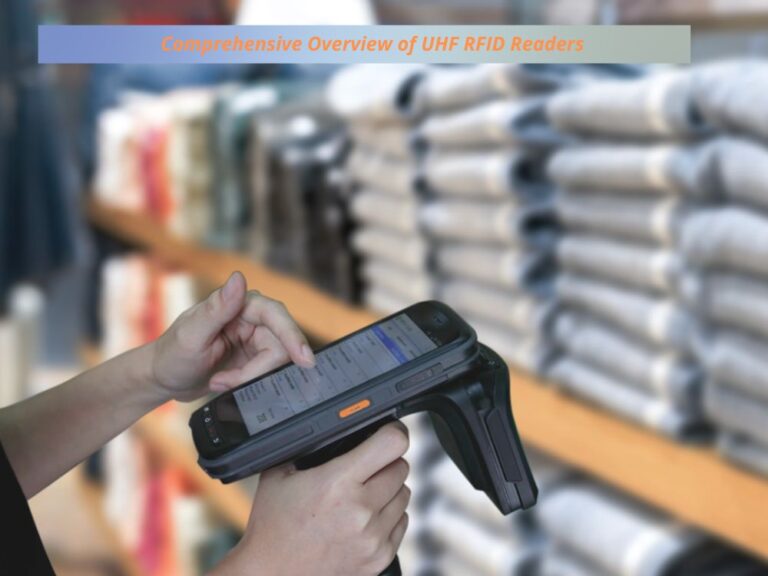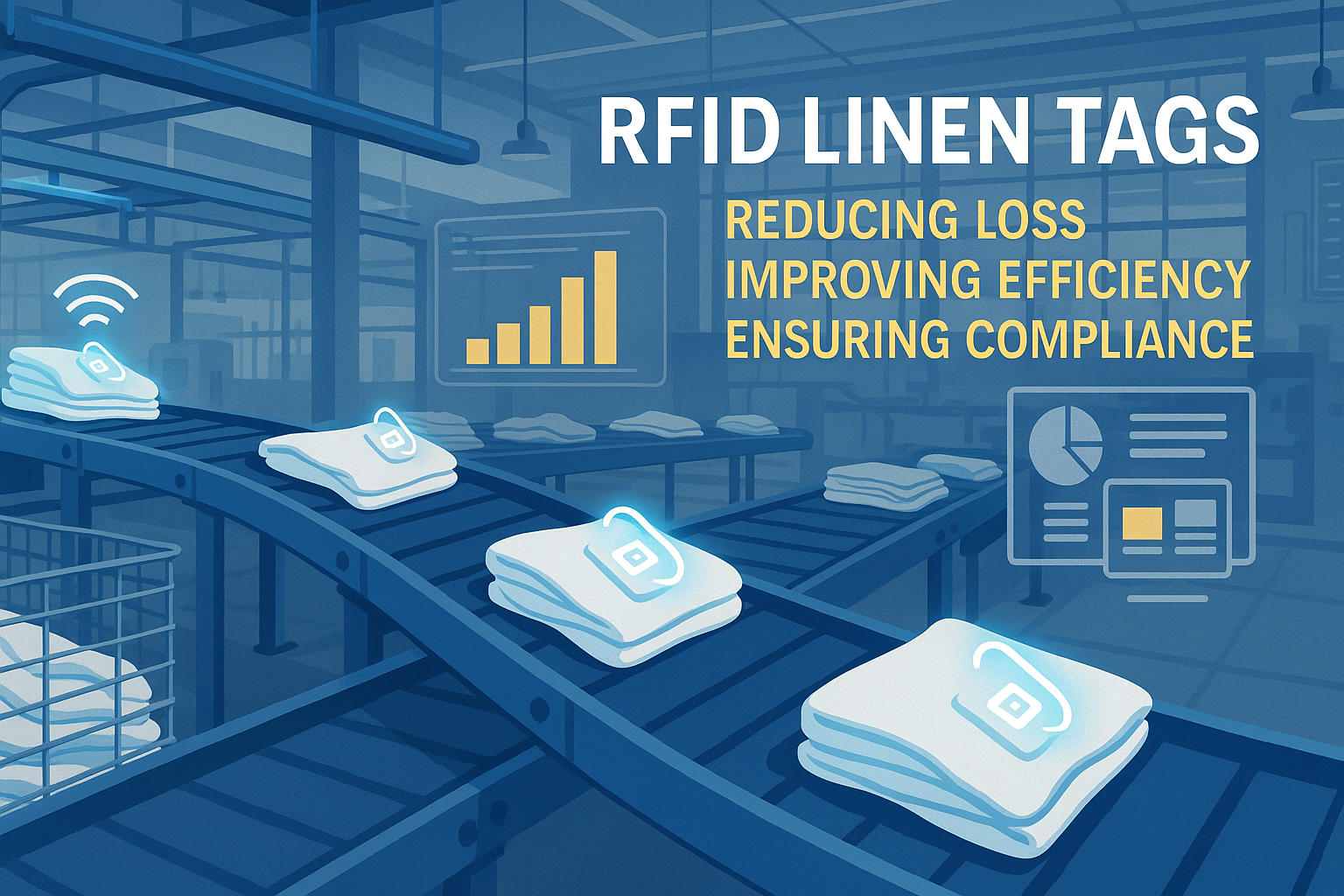
Comprehensive Overview of UHF RFID Readers
Table of Contents
Summary
Utilizing the ultra-high frequency (UHF) spectrum between 860MHz and 960MHz, these readers facilitate long-range, high-speed communication with RFID tags. This article delves into the features, applications, and selection criteria of UHF RFID readers, emphasizing their technological advantages and practical implications.

Understanding UHF RFID Readers
UHF RFID readers are sophisticated devices designed to interact with RFID tags through electromagnetic waves. They operate within the UHF band, allowing for extended reading distances and rapid data transfer. By emitting specific frequency waves via antennas, these readers can communicate with tags over considerable distances, decode transmitted information, and relay it to backend systems efficiently.
How UHF RFID Readers Function
UHF RFID readers function through a seamless interaction between electromagnetic waves and RFID tags. Here’s a simplified breakdown of the process:
- Emission of Electromagnetic Waves: The reader’s antenna sends out radio waves in the UHF spectrum.
- Activation of RFID Tags: RFID tags receive these waves, which activate the embedded chip within the tag.
- Data Transmission: The activated chip sends the stored information back to the reader.
- Data Decoding: The reader decodes this information and transmits it to the connected system for processing.
This process, occurring without physical contact or line of sight, enhances the efficiency and speed of data acquisition.
Key Features of UHF RFID Readers
The following table outlines the core features of UHF RFID readers and their significance in various applications:
Feature | Description |
Long-Distance Identification | Capable of reading up to 10 meters or more, ideal for scenarios requiring extensive tracking. |
High Data Transmission Rate | Supports several hundred kilobits per second, facilitating rapid data exchange. |
Anti-Interference Capability | Employs advanced signal processing to mitigate electromagnetic interference. |
Multi-Tag Recognition | Can simultaneously identify dozens to hundreds of tags, useful for high-volume scenarios. |
High-Precision Recognition | Accurately distinguishes multiple tags in proximity, critical for precise data management. |
Long-Distance Identification
UHF RFID readers are designed to read tags from distances that can exceed 10 meters. This capability is particularly beneficial in logistics and warehousing, where items can be scanned from afar, reducing manual efforts and improving operational efficiency.
High Data Transmission Rate
The speed of data transmission with UHF RFID readers is markedly higher compared to LF and HF systems. This feature supports efficient data collection and processing in environments such as production lines, where quick updates are crucial for real-time monitoring.
Anti-Interference Capability
Advanced signal processing technologies enable UHF RFID readers to perform reliably even in environments with high electromagnetic interference. This robustness is essential in complex industrial settings where stable data transmission is critical.
Multi-Tag and High-Precision Recognition
UHF RFID readers excel in environments where multiple tags need to be read simultaneously. Their ability to identify numerous tags at once and with high precision is beneficial in large-scale inventory and asset management applications.
Applications of UHF RFID Readers
Logistics and Supply Chain Management
UHF RFID readers are instrumental in optimizing logistics and supply chain operations. By integrating readers into warehouses and distribution centers, companies can track goods in real-time, automate inventory processes, and enhance overall efficiency.

Retail
In the retail sector, UHF RFID readers facilitate real-time inventory tracking, automated checkout processes, and theft prevention. Their ability to quickly and accurately count inventory reduces management time and improves customer service.
Asset Management
For asset management, UHF RFID readers monitor the location and status of valuable assets. This real-time tracking helps prevent loss and ensures efficient utilization of assets, particularly in sectors like healthcare where accurate equipment management is vital.
Intelligent Transportation
UHF RFID readers are used in intelligent transportation systems to manage vehicle identification and toll collection. The technology allows for automatic vehicle recognition and processing, enhancing traffic flow and reducing congestion.
Healthcare
In healthcare, UHF RFID readers improve patient safety and medication management. By tracking patient information and medication usage, hospitals can enhance care delivery and prevent errors.
Manufacturing
In manufacturing, UHF RFID readers support material tracking, quality monitoring, and production line management. They enable real-time data collection and process automation, contributing to more efficient production environments.
Choosing the Right UHF RFID Reader
Application Scenarios and Demand Analysis
When selecting UHF RFID readers, consider the specific application requirements, including reading distance, data speed, and environmental conditions. Understanding these needs helps in choosing a reader that aligns with operational demands.
Performance Considerations
Evaluate the reader’s performance based on reading distance, speed, anti-interference capability, and multi-tag recognition. These factors determine the efficiency and effectiveness of the reader in various operational contexts.
Compatibility and Cost-Benefit Analysis
Ensure compatibility with existing systems and assess both initial and long-term costs, including maintenance and energy consumption. Selecting a reader that integrates well with current infrastructure and offers cost-effective operation is crucial.
Supplier Selection
Opt for reputable suppliers who provide robust support and service. A good supplier will offer comprehensive after-sales support, enhancing the longevity and reliability of the RFID system.
FAQs about UHF RFID Readers
What is the typical reading distance for UHF RFID readers?
UHF RFID readers can generally read tags up to 10 meters or more, depending on various factors such as power and antenna design.
How many tags can a UHF RFID reader read simultaneously?
UHF RFID readers can typically handle dozens to hundreds of tags at once, based on the reader’s capabilities and tag density.
Can UHF RFID readers function in complex electromagnetic environments?
Yes, they have strong anti-interference features, but additional measures may be needed in highly complex environments.
What are the main application areas for UHF RFID readers?
Common applications include logistics, retail, asset management, intelligent transportation, healthcare, and manufacturing.
What future developments are expected for UHF RFID readers?
Future advancements may include integration with 5G technology, enhanced functionality, reduced costs, and expanded applications in emerging fields.
UHF RFID readers represent a crucial technology in enhancing operational efficiency across various industries. By understanding their features, applications, and selection criteria, businesses can leverage these devices to achieve significant improvements in data management and operational performance.
Comments
Hot Products

What Is RFID Waste Management
Imagine a city where every trash bin speaks — not literally — but through a tiny chip that tells the system when it’s full, when it’s emptied, and where it went. That’s what RFID waste management is doing today.

What are Bolt Seals and their Applications? | Complete Guide
In global trade and logistics, bolt seals play a crucial role in ensuring cargo security and compliance. These small but powerful devices are designed to lock shipping containers, trailers, and cargo doors with a tamper-evident mechanism.

What is an RFID Card Protector? Benefits, Use Cases, and Buying Guide
RFID technology (Radio Frequency Identification) is everywhere: in your credit cards, ID badges, transit passes, hotel room keys, and more. It offers speed and convenience, but it also opens the door to a new kind of digital theft called “skimming.” That’s where an RFID card protector comes in.

RFID Wristbands for Events: Bulk Buying Guide for Organizers
RFID wristbands for events are becoming the go-to solution for organizers who need faster entry, fraud prevention, and cashless payments at concerts, festivals, and sports venues. Unlike paper tickets or QR codes, these smart wristbands use embedded chips to streamline access, secure transactions, and improve the guest experience.

How RFID Tag on Windscreen Improves Vehicle Access Control and Toll Systems
In today’s fast-paced world, vehicle identification needs to be quick, secure, and contactless. An RFID Tag on the Windscreen provides exactly that — a reliable way to manage toll collection, parking, and gated access without stopping vehicles.

The Benefits of RFID Linen Tags in Commercial Laundry
Managing laundry in hospitals, hotels, or large laundry services is a big job. Each day, thousands of sheets, towels, and uniforms are washed, sorted, and sent back out. But problems like lost linens, sorting mistakes, and manual counting can cost companies a lot of money. For example, mid-sized hotels can lose over $200,000 each year from missing linens.
That’s where RFID Linen Tags come in.
Tags
RELATED BLOGS

What Is RFID Waste Management
Imagine a city where every trash bin speaks — not literally — but through a tiny chip that tells the system when it’s full, when it’s emptied, and where it went. That’s what RFID waste management is doing today.

What are Bolt Seals and their Applications? | Complete Guide
In global trade and logistics, bolt seals play a crucial role in ensuring cargo security and compliance. These small but powerful devices are designed to lock shipping containers, trailers, and cargo doors with a tamper-evident mechanism.

What is an RFID Card Protector? Benefits, Use Cases, and Buying Guide
RFID technology (Radio Frequency Identification) is everywhere: in your credit cards, ID badges, transit passes, hotel room keys, and more. It offers speed and convenience, but it also opens the door to a new kind of digital theft called “skimming.” That’s where an RFID card protector comes in.




